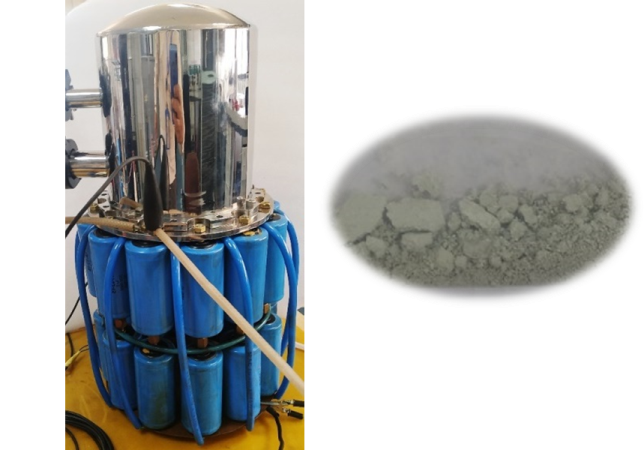Sodium Hypochlorite Electrolyser Plant (SHEP)
The Sodium Hypochlorite Electrolyser Plant
Accessories for spraying
Due to outbreak of COVID-19, there is an urgent need of disinfectants for killing the germs in various buildings and premises. To combat the novel coronavirus that causes the disease commonly known as COVID-19, it’s essential to know how to create and use effective cleaning solutions. Sodium hypochlorite (NaOCl) is one of the proven disinfectant and is being used in sanitization where 0.05-0.5% NaOCl is recommended by WHO and CDC, USA, whereas 1% is recommended by ICMR, India. The Centre for Diseases Control and Prevention (CDC) and the World Health Organization recommend using a sodium hypochlorite bleach solution as one way to disinfect areas contaminated with the novel corona virus. There are many ways of using disinfectants such as: sprays, wipes, and mopping that can help disinfect areas exposed to the novel corona virus.
Sodium hypochlorite has a
very similar destructive effect on proteins present in a virus as heat
stress does and prevents growth of bacteria as a secondary effect. Since
two months of lockdown, availability of sodium hypochlorite (which is
an essential commodity for area disinfection of COVID 19, as per
WHO/ICMR) is affected due to disruption in production and distribution.
This necessitates development of on-site hypochlorite generators. The
unit has been designed such that it can be operated safely by limited
unskilled manpower with readily available raw material (table salt and
water). The unit is a modular one which can be scaled up easily
depending on the requirement.
1 The Sodium Hypochlorite Electrolyser Plant
2 Accessories for spraying
Brief Description
Sodium hypochlorite (NaOCl) is one of the proven disinfectant and is
being used in sanitization where 0.05-0.5% NaOCl is recommended by WHO
and CDC, USA, whereas 1% is recommended by ICMR, India. The Centre for
Diseases Control and Prevention (CDC) and the World Health Organization
recommend using a sodium hypochlorite bleach solution as one way to
disinfect areas contaminated with the novel corona virus. There are many
ways of using disinfectants such as: sprays, wipes, and mopping that
can help disinfect areas exposed to the novel corona virus.
Salient Feature
The present SHEP is able to produce on-site sodium hypochlorite of
0.1-1% concentration as prescribed by WHO/ICMR for use as disinfectant
for sanitizing areas affected due to COVID-19. The energy and current
efficiencies obtained are at par industrial standards. Overall, on-site
electrolysis process offers many advantages such as: reduced operational
costs, consistent solution strength, and production of required volumes
as needed, non-hazardous chemical (feed or product). The on-site
electrolyser requires electricity, salt and water.
Advantages
There is no need of handling corrosive, dangerous gases and can be used
at hospitals/home with ease. The hazard potential of the minute quantity
of chlorine and hydrogen gas generated during the operation is quite
negligible due to safe handling. The Mixed Metal Oxide (MMO) coating on
the anode of the Ti based electrodes is heart of the unit which controls
the selectivity of the desired electrochemical reaction. The design and
operating parameters of the electrolyser provides the required
concentration of product and efficiency of operation.
Areas of Application
Health and hygiene sector for area sterilization of premises.
1 The Sodium Hypochlorite Electrolyser Plant
2 Accessories for spraying
Brief Description
Sodium hypochlorite (NaOCl) is one of the proven disinfectant and is being used in sanitization where 0.05-0.5% NaOCl is recommended by WHO and CDC, USA, whereas 1% is recommended by ICMR, India. The Centre for Diseases Control and Prevention (CDC) and the World Health Organization recommend using a sodium hypochlorite bleach solution as one way to disinfect areas contaminated with the novel corona virus. There are many ways of using disinfectants such as: sprays, wipes, and mopping that can help disinfect areas exposed to the novel corona virus.
Salient Feature
The present SHEP is able to produce on-site sodium hypochlorite of 0.1-1% concentration as prescribed by WHO/ICMR for use as disinfectant for sanitizing areas affected due to COVID-19. The energy and current efficiencies obtained are at par industrial standards. Overall, on-site electrolysis process offers many advantages such as: reduced operational costs, consistent solution strength, and production of required volumes as needed, non-hazardous chemical (feed or product). The on-site electrolyser requires electricity, salt and water.
Advantages
There is no need of handling corrosive, dangerous gases and can be used at hospitals/home with ease. The hazard potential of the minute quantity of chlorine and hydrogen gas generated during the operation is quite negligible due to safe handling. The Mixed Metal Oxide (MMO) coating on the anode of the Ti based electrodes is heart of the unit which controls the selectivity of the desired electrochemical reaction. The design and operating parameters of the electrolyser provides the required concentration of product and efficiency of operation.
Areas of Application
Health and hygiene sector for area sterilization of premises.
| SR NO. | Organization name | Licensee Name | Licensee Code | ACQUIRED ON | Valid Till | Address | City | State | Phone | |
|---|---|---|---|---|---|---|---|---|---|---|
| 01 | M/s. Stellarin Ventures Pvt. Ltd. | Shri Arun Kumar Tiwari | 78 | 15-06-2020 | 15-06-2027 | LIG Mesnet-1, sector-1, Shankar Nagar | Raipur | Chhattisgarh | stellarin.in@gmail.com | 91771 4091538 |
| 02 | M/s Cleanflo India Pvt. Ltd | Shri Shikhar Sharma | 148 | 11-01-2021 | 11-01-2028 | M/s Cleanflo India Pvt. Ltd., 403, Gupta Tower, Commercial Complex, Ring Road | Azadpur | Delhi | shikhar@cleanfloindia.com | 01147003700 |
| 03 | ORIXES ENGINEERING | NAJAR MOHAMMAD | 391 | 14-02-2022 | 14-02-2029 | PLOT NO. L-2, POCKET-H, SECTOR-2, DSIIDC , BAWANA, NORTH WEST DELHI, NEW DELHI-110039 | New Delhi | Delhi | ORIXESENGINEERING@GMAIL.COM | 8527432745 |
| SR NO. | COUNTRY NAME | PATENT NUMBER | |||||||||||
|---|---|---|---|---|---|---|---|---|---|---|---|---|---|
| No Data Found. | |||||||||||||
| SR NO. | NAME | STANDARD NUMBER | LOGO | ||||||||||
|---|---|---|---|---|---|---|---|---|---|---|---|---|---|
| No Data Found. | |||||||||||||
General License Fee : ₹ 17,000.00 (Seventeen Thousand)
General Royalty : 0%

